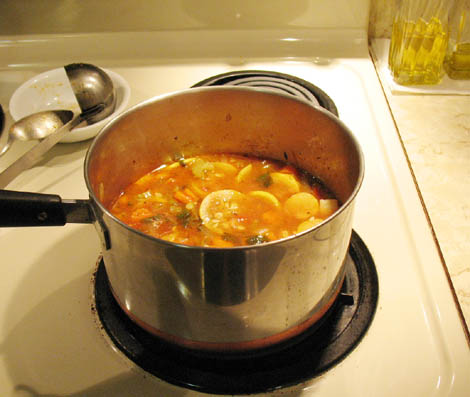January is National Soup Month

January is coming to an end and I’ve neglected to point out that January is officially National Soup Month. Maybe you already knew that, but I didn’t. It sounds reasonable and, besides, I was making soup even before I was told it was National Soup Month. The soup in that pot is minestrone. The Italian word for soup is minestra, and when you make it into a diminutive and say minestrina, that means you’re talking about a thin, clear soup, and when you use the heavy word minestrone, that means it’s a thick soup. Maybe you didn’t know that.
The soup pictured in this post was excellent. Here’s what went into it:
- Tomatoes, 1 small can of diced tomatoes (14.5 oz). Whether or not to use the juice from the can is a judgment call. We used the juice.
- Garlic, 2 cloves, diced.
- Olive oil, 1 and 1/2 tablespoons. You can sauté the garlic in this.
- Onion, 1 sweet white Spanish onion, or any other onion, chopped. Half an onion if it’s a big one.
- Celery, 1 cup chopped.
- Carrots 1 cup, sliced carrots. That’s 2 or 3 good thick ones.
- Yellow summer squash, or zucchini, 2 of them at most, sliced or halved or quartered and sliced.
- Spinach, regular or baby. I tore the spinach up into biggish pieces and I guess 1 or 2 cups full, but I don’t how to measure a cup of spinach.
- String beans. Get a couple of handfuls and cut them up into bite-size pieces. I used a heaping 1/3 cup full and it was fine.
- Bell pepper, sliced to bite size. I added half a red bell pepper. Actually, this was a mistake. It was OK, but I won’t do it again.
- 3/4 cup of ditalini pasta. That was way too much. It’s best to cook up the pasta separately, otherwise it gets mushy.
- Vegetable broth or water. One time I used 1/2 can of vegetable broth and 2 cups of water, and another time I used no broth and 5 cups of water. When I’ve included the juice from the small can of tomatoes, I’ve added 3 cups of water. If the vegetable broth has herbs in it, then you should be careful when adding herbs.
- Wine. 1/3 cup of white wine. Some people add wine to every soup they make. I’m one of those.
- Oregano and parsley, 1/2 teaspoon. of oregano and parsley. Or maybe neither; salt seems to be all you need. Season to taste with salt as you go along, or in the soup bowl.
- Some people add ceci beans (also called chick peas or garbanzo beans). Those beans have all sorts of health benefits and I wish I liked them more, but I don’t. If you like them, open a small can (14 oz), drain the beans and use however much you want.
Get a fresh loaf of Italian or French bread to go with this.
Heat the olive oil and sauté the garlic in the pot you’re going to make the soup in. If you want to add the chopped onions, go ahead, but don’t add more olive oil. Add the broth and/or water and tomatoes, and stir it all. Then toss in the celery and carrots and stir some more. Next, bring it to a boil, then reduce the heat to a simmer. After it’s simmering add the softer stuff – the squash or zucchini, beans and spinach. The last thing to add is the wine and not quite a half teaspoon of parsley – and maybe a pinch of oregano. It’s best to add salt to taste, but that’s hard to do if the minestrone is too hot, so let some cool in a dipper and try it there. If you simmer it too long, things get mushy. A bit crisp tastes better.
By the way, a mix of carrots, celery and onions, roughly chopped and thrown together, is the starting point for a lot of soups, stews, stocks and sauces. These three aromatics, as they are called, are found together in so many recipes that the French have a word for the group — mirepoix. We’re showing off our Italian and French today.
Critical Pages isn’t a recipe site. This post is about what we got when we used these ingredients in this way. Past performance is no guarantee of future results, not even when we do it in our own kitchen. That’s true for a lot of things in life.